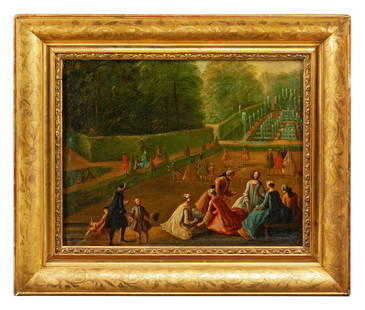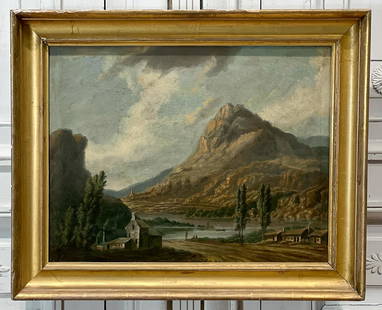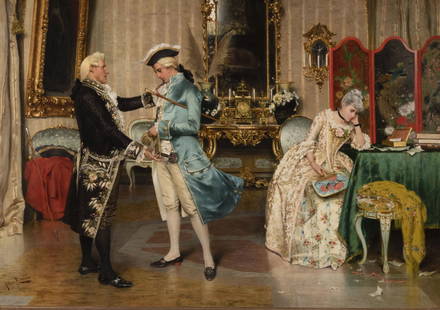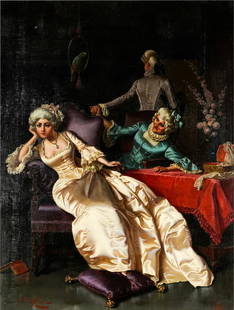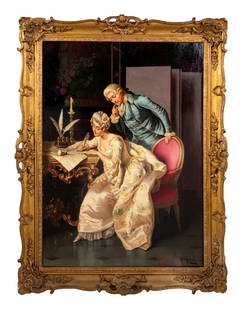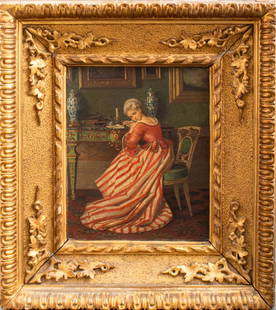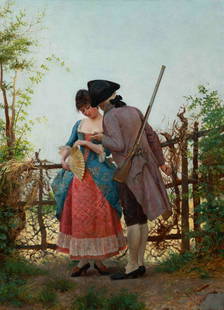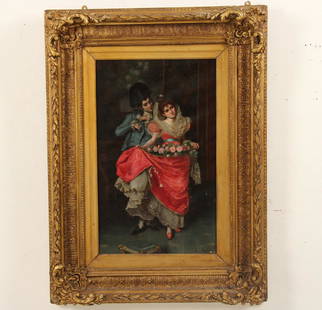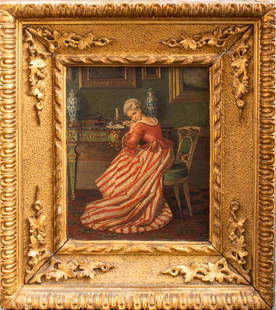PROPERTY OF A PROMINENT ST. LOUIS FAMILY
SEBASTIANO RICCI (Italian, 1659-1735) with MARCO RICCI (Italian, 1676-1730)
The Vision of St. Bruno, circa 1700
Oil on canvas
37 x 47-5/8 inches (94.0 x 121.0 cm)
PROVENANCE:
Counts Francesco Algarotti (Venice 1712-1764 Pisa) and Bonomo Algarotti (before 1712-1776), Venice, by 1776 (described in the catalogue of their collection);
Thence by descent to Francesco's niece and Bonomo's daughter, Countess Elisabetta Algarotti-Corniani, Venice, in 1776;
(Possibly) to her son, Count Bernardino Algarotti-Corniani, Venice;
Joseph Philipson (Posen, Poland 1773-1844 St. Louis), St. Louis, Missouri, by 1844 (most likely by 1820, after which Philipson experienced a reversal of fortune);
Charles Samuel Rannells, Esq., (1813-1877) and Mary Warder Rannells (d. 1896) of St. Louis, Missouri, in 1844-1848, most likely in settlement of legal fees from the estate of Joseph Philipson, until 1896 (the painting hung at "Woodside," the Rannells' family home built in 1848, Maplewood, Missouri);
Thence by descent to their son and daughter-in-law, Maplewood, Missouri, 1896 to 1939;
Thence by descent to their son and daughter-in-law, Webster Grove, Missouri, and subsequently Dexter, Missouri, 1939 to 1972;
Thence by descent to their daughter, Stillwater, Oklahoma, and subsequently Dallas, Texas, 1972 to the present.
LITERATURE:
G.A. Selva and P. Edwards, Catalogue des tableaux, des desseins, et des livres qui traitent de l'art du dessein, de la galerie du feu Comte Algarotti à Venise, Venice, 1776, p. 20;
J. Daniels, L'opera completa di Sebastiano Ricci, Milano, 1976, cat. no. 581 (as a lost work);
J. Daniels, Sebastiano Ricci, Hove, 1976, cat. no. 511b (as a lost work);
A. Scarpa, Sebastiano Ricci, Milan, 2006, cat. no. P/66 (as a lost work).
In downtown St. Louis, Missouri, during the first two decades of the nineteenth century, the city's first permanent Jewish settler, Joseph Philipson (1773-1844), was doing what many other immigrants from Europe were doing in this brand-new, rough-and-tumble gateway to the West: making his fortune in a wide variety of enterprises. Both independently and in partnership with his brothers Simon and Jacob, he was buying real estate, dealing in fur and lead, directing a bank, establishing a brewery, and operating his own dry goods store which stocked a wide array of merchandise--from exotic luxuries such as almonds, coffee, Spanish cigars, ladies' Morocco leather spangled shoes, chocolate, and violins (an instrument he played expertly), to ordinary umbrellas, salted shad, and mackerel.
Shortly after arriving in St. Louis around 1804, via Ohio, Philadelphia, New York, the Virgin Islands, and Hamburg, Germany, the Polish-born Philipson and his new dry goods company on Main Street received a visit from Meriwether Lewis, whom he outfitted for the now-legendary Lewis and Clark expedition across the western United States.
But in one important respect, the cultured Philipson sat far apart from the mercantile crowd during these years immediately surrounding the Louisiana Purchase. From his earliest days in New York and Philadelphia (late 1790s-early 1800s), he was buying Old Master paintings on an ambitious scale and at a feverish rate. At least part of the time, he was working through an English agent he later identified as Sir William Stewart to purchase paintings which flooded the European art market in the wake of Napoleon's armies. In fact, Philipson was not simply the first important collector of Renaissance, Baroque, and eighteenth-century European painting west of the Mississippi: he was one of the first private collectors of Old Master paintings anywhere in the United States.
At the time of his death in St. Louis in 1844, Philipson's estate recorded 390 oil paintings described by subject and frequently by artist: Rubens, Rembrandt, Velasquez, Titian, Van Dyck, Veronese, Zuccarelli, del Sarto, Gaspar Poussin, Paulus Potter, Murillo, Frans Hals, Salvator Rosa, among many others. What is equally remarkable is that this trove of oil paintings included 150 which his brother Simon had collected (not yet discretely identifiable from Joseph's), and which Joseph had inherited upon Simon's death in 1841. Joseph Philipson's tastes, and by extension those of his brother, cut boldly across national schools, and his interest in genres was encyclopedic. The collection included landscapes, still lifes, animal paintings, mythologies, religious subjects, portraits, and scenes of everyday life.
During the late 1830s, both Philipsons tried valiantly to interest the city fathers of St. Louis in purchasing the collection en bloc as the basis for a municipal art gallery. Their goal, as Joseph stated in writing many times, was to establish the first public art gallery in the West. Failing that attempt in St. Louis, Joseph next turned to the city fathers--and mothers--of Cincinnati, using a strategy of trying to sell the collection by subscription for the same purpose. In 1843, he even floated a selection of his holdings up the Ohio River to stage an exhibition in the Queen City's Mercantile Library on Walnut Street in the hope of raising popular interest. When approaching Cincinnati, Joseph Philipson corresponded extensively with British-born Ann Aston Warder of neighboring Springfield, Ohio, the enlightened mother-in-law of his trusted lawyer, Charles Samuel Rannells, who encouraged him in this enterprise. After Cincinnati turned down the collection, he decided to approach Philadelphia. But apparently before he had received an answer, or proffered his Old Masters to New Orleans which was next on his list, Philipson died, leaving the fate of his paintings in the hands of his lawyers.
As the lawyers quickly discovered, Philipson's reversals of fortune following the Panic of 1819, which had devastated his banking enterprise, had taken its toll on his finances. The collection sadly had to be dispersed to pay his debts. This was the scenario Philipson had tried so hard to avoid--something made all the more poignant by the fact that the lifelong bachelor had supported himself during his last 20 years by giving music lessons rather than liquidating his art collection piece by painful piece. In fact, as long as he had been able to do so, Philipson rented rooms in an old building in St. Louis so that he could display his collection as a whole to the public. The profound admiration St. Louis citizenry held for Joseph Philipson's 'highly cultivated mind,' dignified manners and cultural philanthropy, which also included his instrumental involvement in planning a municipal courthouse, was expressed in the outpouring of recognition and respect upon his death (Walter Ehrlich, Zion in the Valley: The Jewish Community of St. Louis, Columbia and London, 1997, pp. 14-32). His funeral cortege was followed by 'at least ten carriages conveying St. Louis' oldest and most respected citizens' and many of its most powerful business and cultural leaders.
Charles Samuel Rannells acquires Philipson's Vision of St. Bruno
Today, the Philipson collection, remarkably, is entirely untraced, save one painting--a magnificent late Italian Baroque scene of The Vision of St. Bruno by the celebrated artist Sebastiano Ricci (1659-1734) with his nephew, Marco (1676-1730), a notable landscape specialist with whom he frequently collaborated. This commanding composition showing the 11th-century founder of the Carthusian order in his trademark white monastic robes, enraptured by a radiant spectacle of angels above him, has descended without interruption in the same American family for the last 160 years.
Charles Samuel Rannells of St. Louis, one of Joseph Philipson's lawyers and a two-term state senator, acquired the painting between 1844 and 1848 directly from the Philipson estate, where it had been listed in the probate inventory of his client's art collection as #123 (St. Louis, Missouri, Municipal Probate Court Records, 1844, case number 01907). According to family legend, Rannells accepted the painting as payment or partial payment for legal fees owed him by Philipson's estate. Surviving correspondence between Joseph Philipson and Charles Rannells' wife and mother-in-law (Mary Warder Rannells and Ann Aston Warder) from 1843 hints at the reason Rannells would have accepted the painting in settlement. The two women were familiar with the contents of Philipson's art collection and would have recognized The Vision of St. Bruno as a work of great quality. (Mary apparently acted as Philipson's 'curator,' having met him around the time of her marriage to Charles Rannells.)
The painting's grand design, confident use of a rich Venetian palette, fluid brushwork, and beautifully preserved surface show Sebastiano Ricci at his finest. The work is a prime example of why the artist had enjoyed wide appeal in eighteenth-century England, France, and Austria as well as his native Italy. Artistically, he forged an important bridge between the late Baroque of Luca Giordano, and the more highly-keyed pastel palette and flickering touch of the Venetian Rococo virtuoso, Giambattista Tiepolo. The two tendencies merge harmoniously in this work. The sculptural insistence of the paint and sonorous mood of the older style define the reclining figure of the ecstatic monk, while the prismatic explosion of hovering angels anticipates Tiepolo.
During its life in the Rannells family, The Vision of St. Bruno has had four generations of owners and has been proudly displayed in five consecutive family homes in Maplewood, Missouri (Charles S. Rannells's farm, Woodside, just outside St. Louis); Webster Grove, Missouri; Dexter, Missouri; Stillwater, Oklahoma; and Dallas, Texas. During this entire period, the painting had never been publicly exhibited or reproduced.
Moreover, recent research has revealed that the painting's art historical significance reaches beyond its importance as the sole traceable work from the Philipson collection, and as a gauge for that collection's quality as a whole. It is a rediscovered masterwork which once belonged to the great Venetian connoisseur, Francesco Algarotti (1712-1764), who, among other notable cultural achievements, shaped the Royal Collection in Dresden into the stunning chronological history of European painting it is today.
The Lost Algarotti St. Bruno Rediscovered
The Philipson-Rannells painting is the lost Vision of St. Bruno from the famed Algarotti collection of Venice, begun by Count Francesco Algarotti's father and his older brother, Bonomo, a successful merchant and banker. Casanova mentioned the latter in his infamous memoirs as having, besides lots of influence, 'the finest wine cellar in all of Venice.'
Francesco Algarotti significantly enlarged the family art collection by some 200 paintings and works on paper, while distinguishing himself across the continent and in England as one of the most discerning art connoisseurs, patrons, and critics of the eighteenth century. In addition to his wealth, ambition, and dashing good looks which endeared him (intimately) to both sexes (he was a longtime companion of Frederick the Great of Prussia), Francesco Algarotti earned the reputation as an art agent with superb taste in paintings regardless of period and uncanny foresight in spotting outstanding new talent. He became, for example, one of the first figures to champion Tiepolo's daring new manner and palette and managed to convince Augustus III, King of Poland and Elector of Saxony, to buy new work from Tiepolo as well as other contemporary Venetian painters for his Dresden gallery. The Saxon ruler's admiration for the slightly older Sebastiano Ricci matched Algarotti's own and in fact predated his involvement with Algarotti; the King's father, King Augustus II, had independently commissioned Ricci to paint an Ascension in 1702-1704 to convince others of the sincerity of his conversion to Catholicism. That had been requisite to his receiving the Polish crown.
With Algarotti's wise counsel, Augustus III ended up forming one of the finest collections of contemporary Venetian painting in Europe, although such an enterprise was in direct opposition to the King's original desire to accumulate only the very best efforts of painters from previous generations. Fortunately, Algarotti enabled him to fulfill this wish just as brilliantly with acquisitions by Hans Holbein, Veronese, Palma Vecchio, Bernardo Strozzi, Domenico Fetti, and many others. One of Algarotti's most inspired acquisitions for Dresden, however, remains Jean-Etienne Liotard's masterpiece, The Chocolate Maid, which the artist was loath to part with. By many accounts, this transaction required Francesco Algarotti to muster every ounce of his considerable powers of persuasion to convince the pastellist to sell it to him for Dresden. Given Algarotti's passion for Venetian painting, it is probable that Francesco, rather than his brother, added Ricci's Vision of St. Bruno to the family art gallery.
Upon his death, the Venetian nobleman's vast collection passed to his brother Bonomo, and upon the latter's demise, passed in turn to his daughter and only heir, Contessa Elisabetta Algarotti-Corniani, and thence to her son Bernardino. It was Contessa Corniani who privately published in Venice a full catalogue of the Algarotti collection in French and Italian as a eulogy to her father and uncle. That source [G.A. Selva and P. Edwards, Catalogue des tableaux, des desseins, et des livres qui traitent de l'art du dessein, de la galerie du feu Comte Algarotti à Venise, Venice, 1776, p. 20] documents three oil paintings by Sebastiano Ricci, including this Vision of St. Bruno, described as follows:
S. Bruno in a beautiful landscape. He is reclining on the ground,
& contemplating a glory of Angels. Behind him in the distance one
of his companions is asleep under a tree. The landscape is
from the hand of Marco, his nephew.
On canvas, 3 [Parisian] feet high, 4 [Parisian] feet long.
The same collection catalogue also lists seven ink and wash drawings by Sebastiano and seven landscapes in distemper and 56 pen drawings by Marco, most of which were caricatures of actors and actresses from the Venetian opera--another great enthusiasm of Francesco Algarotti's.
Until the recent discovery of the Philipson-Rannells painting, The Vision of St. Bruno by Sebastiano Ricci described in the catalogue of the Algarotti collection was known only through a copy published by Rodolfo Pallucchini in 1950 ("Giunte a Sebastiano Ricci," Proporzioni, III, 1950, p. 213, pl. CCXI). This work, which Roberto Longhi had discovered in the Marabini Collection, Bologna, is an early but clearly inferior treatment of the subject. The brushwork and drawing have none of the vivacity and conviction of the Philipson-Rannells painting. An X-ray of the latter provides additional evidence of the assurance with which the figures, landscape, and still-life motifs were decisively drawn.
In 1976, in his pioneering catalogue raisonné, Jeffrey Daniels became the first scholar to document the Algarotti Vision of St. Bruno as a lost work by Sebastiano Ricci. In his catalogue entry on the Algarotti painting, Daniels mentioned the copy in the Marabini collection which Pallucchini had published, but he did not accept it as an autograph work by Ricci. In the most recent catalogue raisonné on Sebastiano Ricci, Annalisa Scarpa concurred with Daniels's opinion that the Algarotti Vision of St. Bruno was a lost autograph work and by implication that the Marabini painting was a copy, because she, like Daniels, did not award the Marabini picture its own entry. Neither Scarpa nor Daniels made reference in their catalogues to a painting briefly noted in a Thieme-Becker entry on Sebastiano Ricci (vol. XXVIII, 1934, p. 253) as St. Bruno in a Landscape (Hl. Bruno in Landschaft) in the collection of the Italian filmmaker, Augusto Mazzetti, Florence, possibly the Marabini painting or another early copy of the Algarotti Ricci.
The original patron of Ricci's Vision of St. Bruno is as yet unknown. Stylistically, however, the painting would seem to date from circa 1700 when the artist first began moving away from Baroque tenebrism to adopt a more high-keyed palette. Moreover, the figures resemble those populating Ricci's 1706 fresco cycle for the Palazzo Marucelli in Florence, a commission on which he collaborated with Marco.
St. Bruno in European painting
The subject of St. Bruno found its greatest expression in European painting within Sebastiano Ricci's lifetime, from the 1650s through the middle of the eighteenth century. The miracles St. Bruno performed, the episode of his angelic vision, his order's devotion to a contemplative existence, and the transcription of important religious texts became popular painting subjects only after his feast day of October 6 had been placed on the Roman calendar in 1623. (He was never formally canonized because of the Carthusians' aversion to public honors, but Pope Leo X granted the Carthusians permission to celebrate his feast beginning in 1514.)
Because St. Bruno's most significant monastic activities occurred in France and Italy, images of the saint were most popular among painters from those countries, notably Pier Francesco Mola, Andrea Sacchi, Giovanni Battista Gaulli, Eustache Le Sueur, and Charles de La Fosse. St. Bruno founded the first Carthusian monastery in Grenoble and the first Carthusian monastery in Italy at Santa Maria della Torre, deep in Calabria's Apennine Mountains. The rugged landscape and the round charterhouse of St. Stephen with its distinctive tower in the center of The Vision of St. Bruno refer to the Italian monastery where the monk reportedly experienced his angelic vision.
Ricci treated the subject of St. Bruno in other paintings as well, although exclusively in vertical format, showing the monk on his knees venerating the Madonna and Child. This horizontal composition, by contrast, devotes far more of the picture surface to the dynamic figure of the saint in the throes of his spiritual experience, and the effect is more visually engaging. While departing from the traditional vertical format for the St. Bruno subject, Ricci incorporated nearly all of the saint's conventional attributes. The ground is bare beneath his feet because grass does not grow where the holy man rests. His body is lean from fasting--something accentuated by the voluminous garment which shows little of his form beneath it. This seems to be Ricci's deliberate quote of Bernini's Ecstasy of St. Teresa (Santa Maria della Vittoria, Rome), since St. Bruno is also portrayed in a moment of spiritual rapture. The monk's literary pursuits are underscored by the presence of books and parchments, while his devotion to the spiritual over corporal realm is emphasized by the presence of a skull, crucifix, and rosary. Ricci's painting owes its greatest artistic debt to Pier Francesco Mola's formulation of the subject which he painted in several versions during the 1660s (now in collections of the Getty Museum, Los Angeles, and the Vatican Museums, Rome). Ricci has borrowed a similar pose for the saint but reversed his position within the design. Having chosen a horizontal canvas, Ricci was also able to recline the figure more dramatically than Mola who had used a vertical support.
The fate of the Algarotti collection is not as entirely obscured as that of the Philipson collection, though much of it remains untraced, and its dispersal occurred more slowly over time. The family's Bartolomeo Vivarini Virgin and Child with SS. Paul and Jerome, for example, entered the permanent collection of the National Gallery, London, during the early nineteenth century through Bernardino Algarotti-Corniani, as did two mythological scenes by Andrea Schiavone and a Portrait of Etienne Nani by Bernardino Licinio (whom the Algarottis had attributed to Pordenone). The museum in Brescia now owns the self-portrait by Giulio Carpioni.
Although Joseph Philipson and Francesco Algarotti were quite literally oceans apart, they both perceived something exceptional in this expression of Ricci's talent. They also shared a desire to express their creativity by striving to assemble the finest painting collections of their time. Algarotti's work in Dresden is a lasting testament to his marvelous eye. Perhaps as more of Philipson's collection comes to light, we may learn that he, too, succeeded in accomplishing, at least for a brief time, something not all that dissimilar from Francesco Algarotti. Certainly The Vision of St. Bruno gives every indication that the first art museum in the West had been something quite extraordinary.
CONDITION REPORT:
The general condition of this painting is excellent. There is no paint loss of consequence to any significant part of the composition and only isolated areas of abrasion.
Applied to a coarse-weave canvas, the paint has a richly impastoed texture. There are only small losses on the right edge and in the upper center, as documented by and clearly visible in the attached X-ray (recently made by the Kimbell Art Museum). Although relined some 30 years ago and mounted on a modern stretcher, the edges of the original canvas are intact and the integrity of the brushwork richly preserved. Beautiful passages of local color appear on the wings of the angel, on the drapery fluttering above it, and in the still life of the skull, cross, rosary and books in the right foreground. The landscape employs a rich azure blue that serves as a foil to the two trees in the left foreground, convincingly attributed to Marco Ricci.
Although the draperies of the angel and St. Bruno have been strengthened in the dark zones of the folds, the restorations are primarily limited to minor areas where the original stretcher bars impressed upon the canvas: within 3 to 5 inches of the right edge, along the lower edge, down the vertical midline of the canvas at upper center, and in the architecture of the church in the left background. An ultraviolet image of the painting made by the Kimbell Art Museum in February of 2008, available online, records the limited extent of the restorations.
The painting will benefit from the removal of many of these small restorations, a new surface coating, and a period-appropriate frame.
A UV photograph documenting all of the restorations is available, as well as an X-ray documenting the condition of the linen support.
Condition Report: The general condition of this painting is excellent. There is no paint loss of consequence to any significant part of the composition and only isolated areas of abrasion.
Applied to a coarse-weave canvas, the paint has a richly impastoed texture. There are only small losses on the right edge and in the upper center, as documented by and clearly visible in the attached X-ray (recently made by the Kimbell Art Museum). Although relined some 30 years ago and mounted on a modern stretcher, the edges of the original canvas are intact and the integrity of the brushwork richly preserved. Beautiful passages of local color appear on the wings of the angel, on the drapery fluttering above it, and in the still life of the skull, cross, rosary and books in the right foreground.
The landscape employs a rich azure blue that serves as a foil to the two trees in the left foreground, convincingly attributed to Marco Ricci.
Although the draperies of the angel and St. Bruno have been strengthened in the dark zones of the folds, the restorations are primarily limited to minor areas where the original stretcher bars impressed upon the canvas: within 3 to 5 inches of the right edge, along the lower edge, down the vertical midline of the canvas at upper center, in the architecture of the church in the left background. The ultraviolet image of the painting made by the Kimbell Art Museum in February of 2008 records the limited extent of the restorations.
The painting will benefit from the removal of many of these small restorations, from a new surface coating, and a period-appropriate frame.
An UV photograph documenting all of the restorations is available, as well as an X-ray documenting the condition of the linen support.
Alternate Artist Spellings: "Ricci, B.", "Ricci, Sebastiano", "Rizzi, Sebastiano", "Sab. Ricci", "Sabastian Rici", "Seb Ricci", "Seb. Ricci", "Sebastian Ricci", "Sebastian Ritcher", "Sebastiano Ricchi", "Sebastiano Ricci", "Sebastiano Rizzi", "Sebn. Ricci", "Sebr. Ricci"
Shipping: Requires 3rd Party Shipping (




















